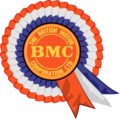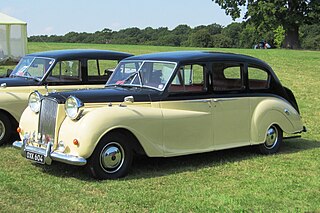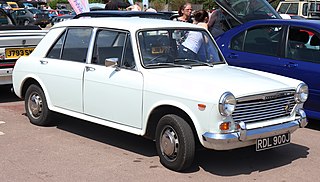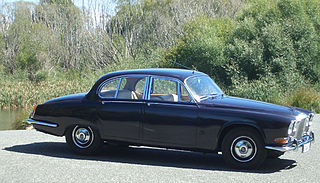
The Daimler Company Limited, before 1910 known as the Daimler Motor Company Limited, was an independent British motor vehicle manufacturer founded in London by H. J. Lawson in 1896, which set up its manufacturing base in Coventry. The company bought the right to the use of the Daimler name simultaneously from Gottlieb Daimler and Daimler-Motoren-Gesellschaft of Cannstatt, Germany. After early financial difficulty and a reorganisation of the company in 1904, the Daimler Motor Company was purchased by Birmingham Small Arms Company (BSA) in 1910, which also made cars under its own name before the Second World War. In 1933, BSA bought the Lanchester Motor Company and made it a subsidiary of the Daimler Company.

The British Motor Corporation Limited (BMC) was a UK-based vehicle manufacturer, formed in early 1952 to give effect to an agreed merger of the Morris and Austin businesses.

The Austin Princess is a series of large luxury cars that were made by Austin and its subsidiary Vanden Plas from 1947 to 1968. The cars were also marketed under the Princess and Vanden Plas marque names.

Vanden Plas is the name of coachbuilders who produced bodies for specialist and up-market automobile manufacturers. Latterly the name became a top-end luxury model designation for cars from subsidiaries of British Leyland and the Rover Group, it was last used in 2009 to denote the top-luxury version of the Jaguar XJ (X350).

The Jaguar S-Type is an executive car that debuted at the 1998 Birmingham Motor Show and was marketed by Jaguar for model years 1999–2007, reviving the nameplate of the company's 1963–68 S-Type as a four-door notchback saloon. The S-Type received a mild facelift for model year 2002 and again in 2004. The S-Type was discontinued in late 2007 and replaced by the XF.

The Jaguar XJ is a series of full-size luxury cars produced by British automobile manufacturer Jaguar Cars from 1968 to 2019. It was produced across five basic platform generations with various updated derivatives of each. From 1970, it was Jaguar's flagship four-door model. The original model was the last Jaguar saloon to have had the input of Sir William Lyons, the company's founder, and the model has been featured in countless media and high-profile appearances.

The Austin-Healey 3000 is a British sports car built from 1959 until 1967. It is the best known of the "big Healey" models. The car's bodywork was made by Jensen Motors and the vehicles were assembled at BMC's MG Works in Abingdon, alongside the corporation's MG models.

The Jaguar Mark X, later renamed the Jaguar 420G, was British manufacturer Jaguar's top-of-the-range saloon car for a decade, from 1961 to 1970. The large, luxurious Mark X not only succeeded the Mark IX as the company's top saloon model, but radically broke with both its predecessor's styling and technology.

The BMC ADO16 is a range of small family cars built by the British Motor Corporation (BMC) and, later, British Leyland. Launched in 1962, it was Britain's best-selling car from 1963 to 1966 and from 1968 to 1971. The ADO16 was marketed under various make and model names; however, the Austin 1100 and Morris 1100 were the most prolific of all the ADO16 variants. The car's ubiquity at the height of its popularity led to it simply being known as the 1100 (eleven-hundred) in its home market. Also made with a 1300cc engine, it was then typically called 1300.

The Wolseley 6/99 and 6/110 were the final large Wolseley cars. Styled by Pininfarina with additions by BMC staff stylists, the basic vehicle was also sold under two of BMC's other marques as the Austin A99 Westminster and Vanden Plas Princess 3-Litre. Production began in 1959 and the cars were updated and renamed for 1961. The Wolseley remained in production as the Wolseley 6/110 through to 1968.

The Austin Westminster series are large saloon and estate cars that were sold by the British manufacturer Austin from 1954, replacing the A70 Hereford. The Westminster line was produced as the A90, A95, A99, A105, and A110 until 1968 when the new Austin 3-Litre took its place. Essentially badge-engineered versions of the Farina Westminsters were also produced using the premium Wolseley and Vanden Plas marques. 101,634 Westminsters were built.

The Humber Super Snipe is a car which was produced from 1938 to 1967 by British-based Humber Limited.

The Jaguar Mark 2 is a mid-sized luxury sports saloon built from late 1959 to 1967 by Jaguar in Coventry, England. The previous Jaguar 2.4 Litre and 3.4 Litre models made between 1955 and 1959 are identified as Mark 1 Jaguars.

The Daimler DS420, also known as the Daimler Limousine, is a limousine made by the Daimler Company between 1968 and 1992. The car was designed for official use and it was popular with chauffeur services, hoteliers and undertakers. It was used as an official state car in many countries. No other limousine model has been delivered to more reigning monarchs than the DS420, and the car is still used by the royal houses of the United Kingdom, Sweden, Denmark, and Luxembourg.

The Daimler DR450 is a limousine variant of the Majestic Major DQ450 saloon. Produced from 1961 to 1968, it was the last complete car designed by The Daimler Company Limited.

The Jaguar Mark 1 is a British saloon car produced by Jaguar between 1955 and 1959. It was referred to in contemporary company documentation as the Jaguar 2.4 Litre and Jaguar 3.4 Litre. Its designation as Mark 1 was retroactive, following its October 1959 replacement by Jaguar's 2.4-litre Mark 2. The 2.4 Litre was the company's first small saloon since the end of its 1½ and 2½ Litre cars in 1949, and was an immediate success, easily outselling the larger much more expensive Jaguar saloons.

Daimler Sovereign was a name applied by British manufacturer Jaguar Cars to a sequence of luxury automobiles built by it but carrying the Daimler badge between 1966 and 1983.

The Jaguar XJ (X300) is a full-size luxury saloon car manufactured by Jaguar Cars between 1994 and 1997. It was the first Jaguar XJ produced entirely under Ford Motor Company ownership, and can be considered an evolution of the outgoing XJ40 generation. Like all previous XJ generations, it features the Jaguar independent rear suspension arrangement. The design of the X300 placed emphasis on improved build quality, improved reliability, and a return to traditional Jaguar styling elements.

The Jaguar XJ (X308) is a full-size luxury saloon car manufactured and marketed by Jaguar Cars for years 1997–2003 across two generations and featuring the Jaguar AJ-V8 engine and Jaguar independent rear suspension. It was the third and final evolution of the Jaguar XJ40 platform that had been in production since 1986. It was preceded by the Jaguar XJ (X300).


























